New Archival Document about the Sale of Jacob Jordaens’ House in 1708
Dr. Leen Kelchtermans
In 1618, approximately a year after he had enrolled as a master painter in the Guild of St Luke, the Flemish Baroque master Jacob Jordaens (1593-1678) and his wife bought two adjoining houses located to the rear of the houses in Hoogstraat, Antwerp. In 1639, the couple acquired a third property, De Halle van Turnhout. Jordaens had these three houses converted into a large complex. The painter not only designed the Baroque facades of the inner courtyard, of which the west and east facade have been preserved, but also embellished the interior with impressive works of art. In 1652, he produced nine spectacular ceiling paintings depicting the love story of Cupid and Psyche for his reception room. The series now belongs to The Phoebus Foundation’s collection.1 In the reception room Jordaens received important guests and showcased his artistic talent. He literally and figuratively displayed his capabilities as a painter. The foreshortening is astonishing: the figures appear to be descending into the room!
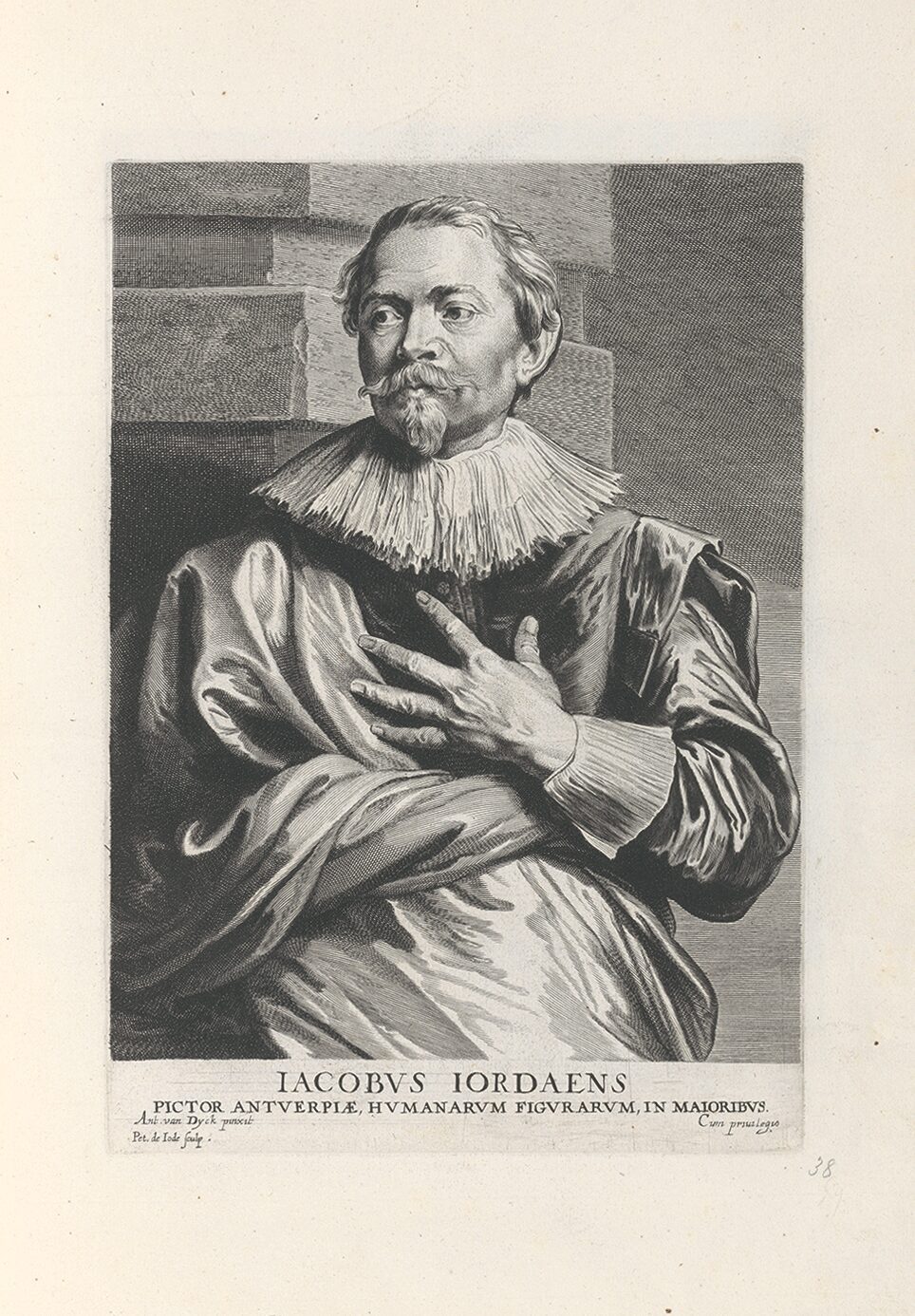
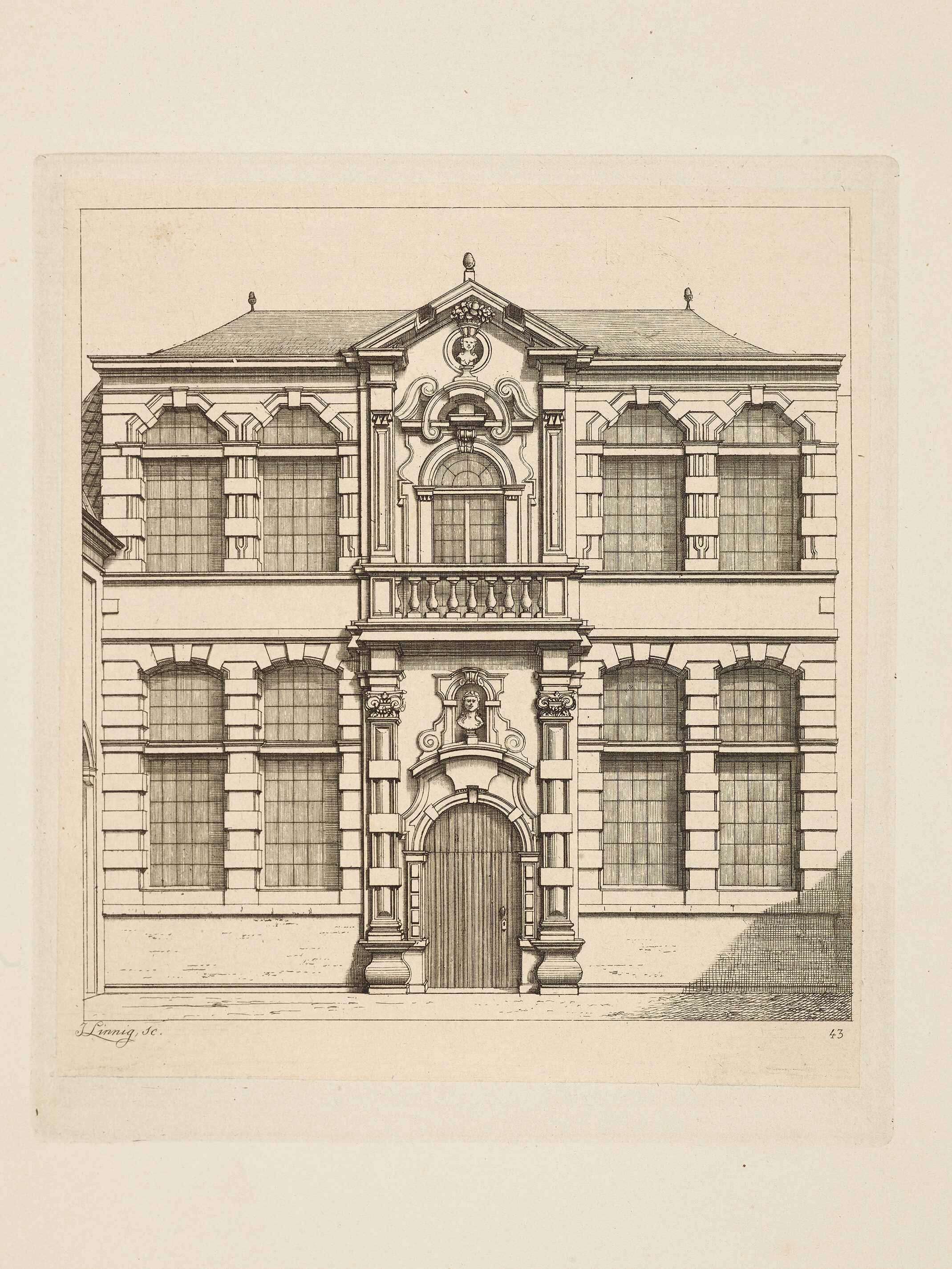
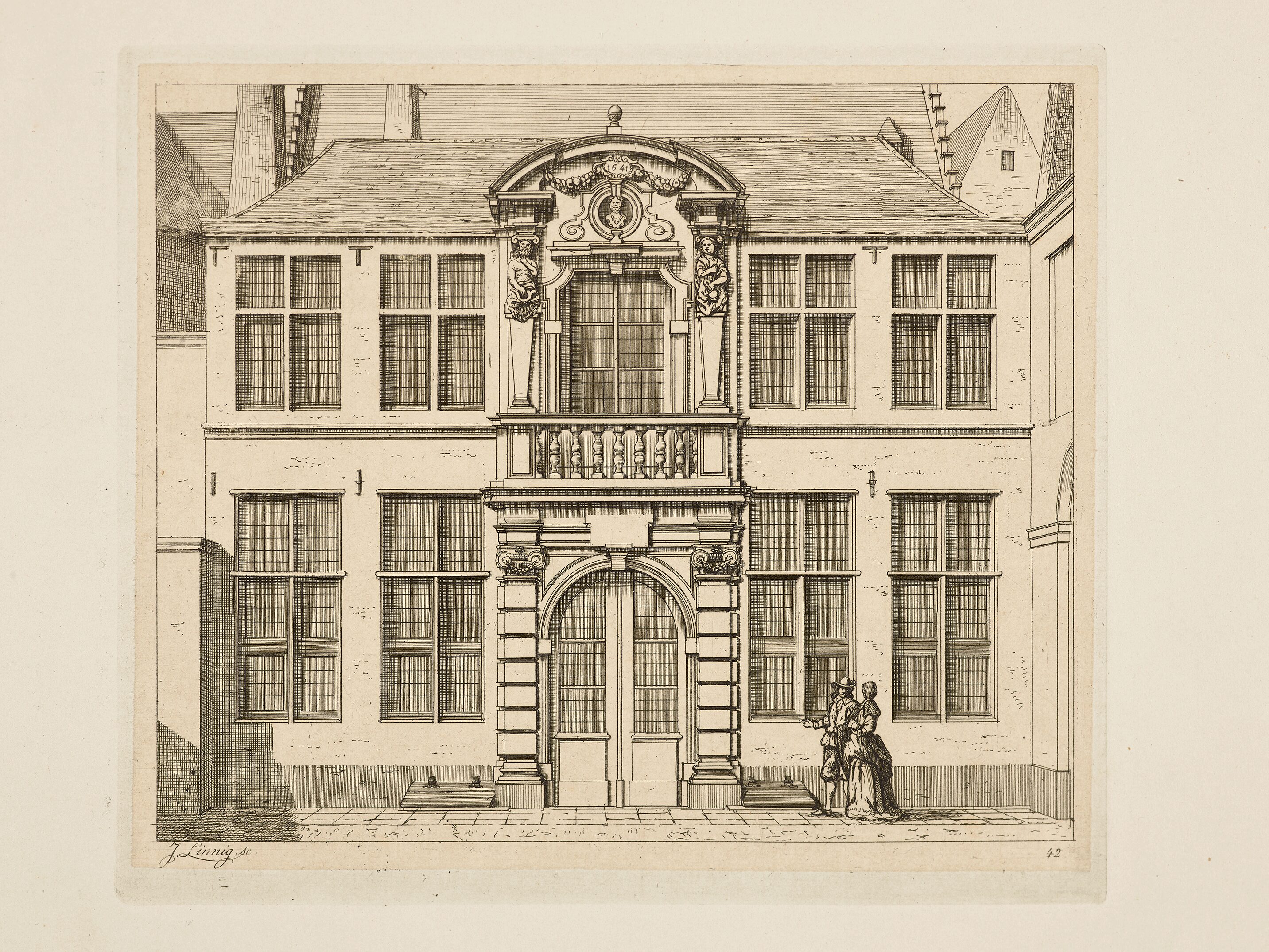
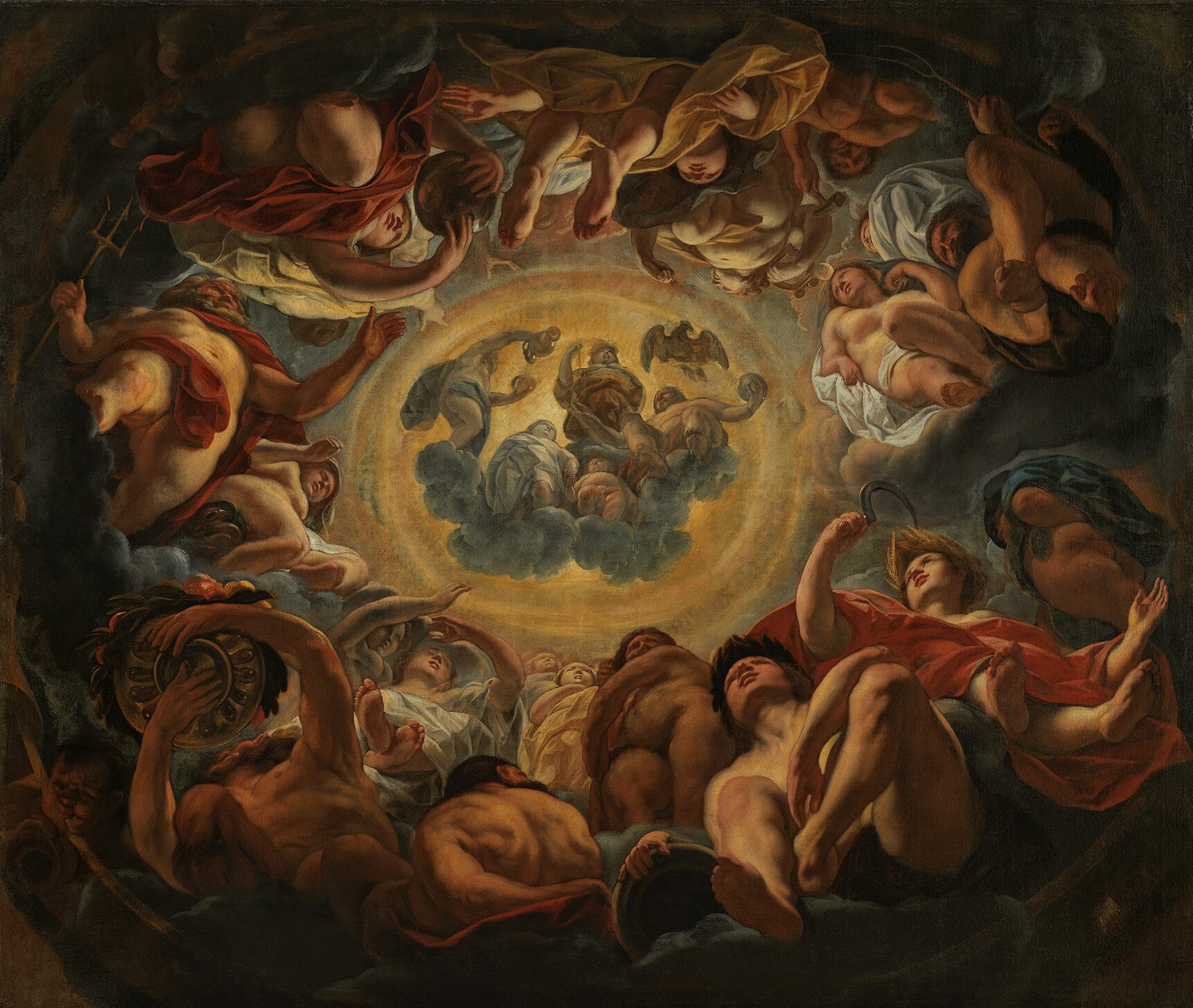
When Jordaens died during the night of 18 October 1678, from a contagious disease that was raging through Antwerp, he had not drawn up a will. As his son Jacob II had died in around 1650, his wife Catharina in 1659, his youngest daughter Anna Catharina in 1676 and his oldest daughter Elisabeth a few hours after her father, only his son-in-law Johannes Wierts II and his grandchildren – who were also Jordaens’ godchildren – were left as heirs. Johannes Wierts II was a lawyer and became a member, and later president, of the States Council of Brabant in The Hague, where he died in 1695. As a result, Jordaens’ house in Antwerp came into the possession of Jordaens’ grandchildren Susanna Catharina and Johan Jacob Wierts. The latter followed in the footsteps of his father and became a lawyer at the Court of Holland. Later he fulfilled the prestigious role of chairman and auditor of the estates of the English King William III. Susanna Catharina married twice, each time to a man of standing. For example, her second husband, Anthonis Slicher, was a member of the Court of Holland, Zeeland and Friesland. Brother and sister Wierts lived in The Hague.2

The extensive publication by Rutger Tijs on Jordaens’ house already revealed that it was sold on 7 July 1708, to the Antwerp cloth merchant Jacobus Ambachts and his wife Maria Catharina Pauwels.3 However, a notary deed recently discovered in The Hague’s municipal archives states that the sale had already been concluded a month and a half earlier. On 21 May 1708, Johan Jacob and Susanna Catharina Wierts, accompanied by her then husband Anthonis Slicher, appeared before Jeremias Stael, a notary in The Hague, as ‘the only surviving children and heirs [in the margin: living here in The Hague; known to me the notary] of the late Lady Anna Catharina Jordaens, wife of the late Mr Johan Wierts, former President of the Council of Brabant, and the only surviving daughter and heir of the late Mr Jacques Jordaens, her father, who lived in the City of Antwerp and died there ab intestato.’4
In the document they grant Antwerp notary Peter Johan Allefelt power of attorney to sell their grandfather’s house in their name to the Ambachts-Pauwels couple, to take care of the related administration and collect the purchase price.5 Jordaens’ property is described as follows: ‘a large house with various rooms, garden, land, and all accessories, located in Hoogstraat in the aforementioned City of Antwerp, called Halle van Turnhout, along with a small house with a ground floor, kitchen, [living] room and adjoining courtyard.’6
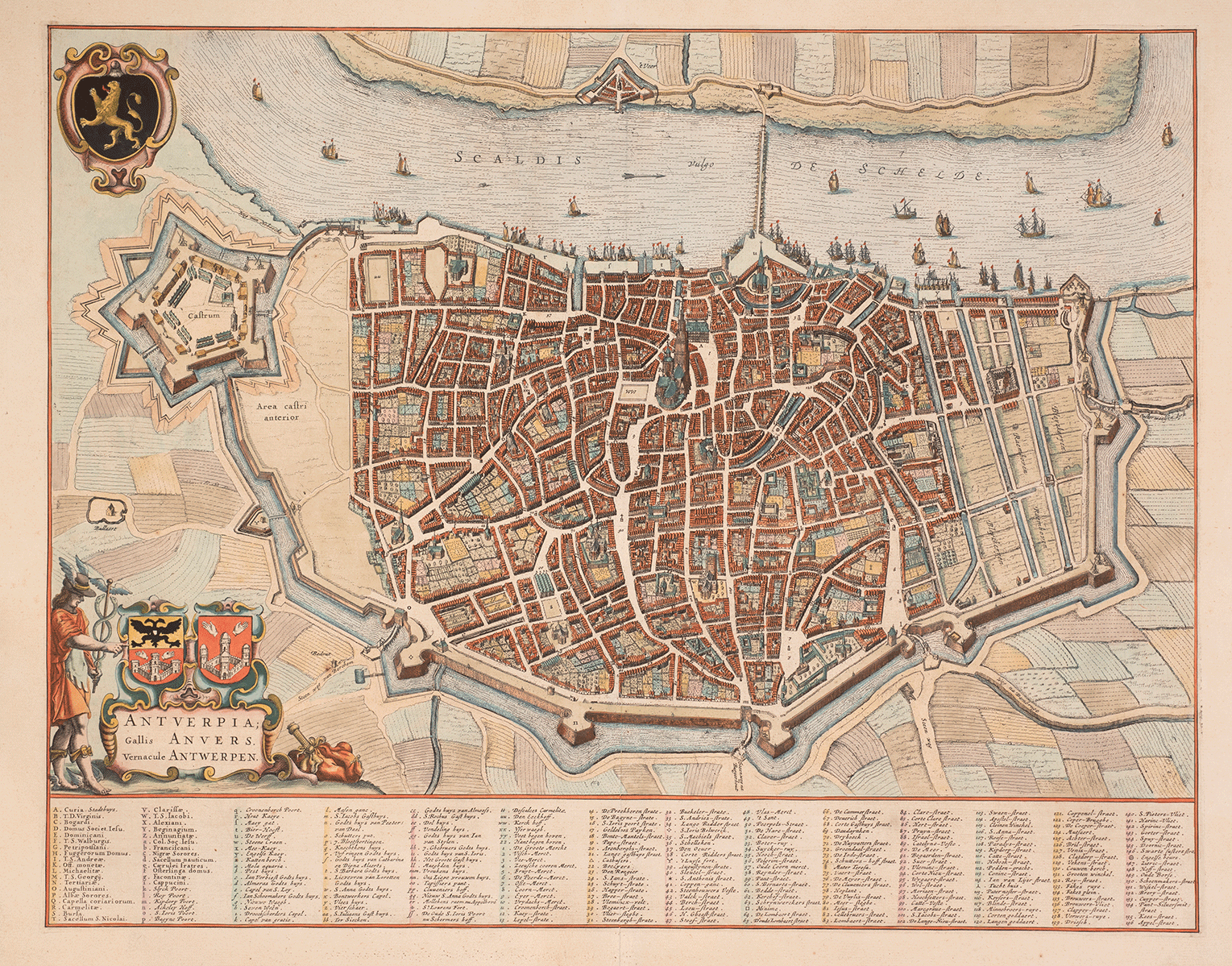

Notary Allefelt was also instructed to publicly sell four other houses in Antwerp owned by Johan Jacob and Susanna Catharina Wierts at the Friday market. They included the house where Jacob Jordaens was born, Het Paradijs in Hoogstraat, De Fruithoorn on Oude Beurs and two adjoining properties on Verversrui. Jordaens had inherited Het Paradijs from his parents in 1634 and had bought the houses on Verversrui almost a year later.7 De Fruithoorn had fallen into the hands of Jordaens’ grandchildren through the inheritance of their great-grandfather Adam Van Noort.8
Allefelt did not manage to sell the four houses. Therefore, on 27 March 1710, Johan Jacob and Susanna Catharina Wierts appointed Jasper Vander Veken Le Jeune as their new trustee. He was to take over Allefelt’s ‘administration of the houses the parties appearing before the notary still owned in the City of Antwerp, receive the rents from said houses and take care of the necessary provisional repairs, as well as to sell the aforementioned houses at the price constituted by the appointed gentleman through the subsequent exchange of letters with the Constituents,’ and naturally transfer them the sum of the sale.9 Three years later, on 21 March 1713, Jacob Jordaens’ grandchildren granted power of attorney to a certain ‘Susanna Begoden, widow of Frans de Coninck.’10
The document discovered in The Hague’s municipal archives specifies the period during which the house of Jacob Jordaens in Antwerp ceased to belong to the painter’s family possessions. It makes it clear that Jordaens’ grandchildren wanted to sell their Antwerp property in May 1708. It is possible that the underlying reason for this decision was the administrative burden involved. If they rented out the houses they had to appoint someone to follow up payment of the rent and also be responsible, for example, for any repairs. Nevertheless, Johan Jacob and Susanna Catharina Wierts did not sell off their grandfather’s entire inheritance. Until her death in 1719, Susanna Catharina resided in his country house, Het Lusthof, in present-day Leidschendam-Voorburg. And Johan Jacob retained the large number of paintings produced by Jordaens, which were transferred from the house in Antwerp to decorate his own property in Nobelstraat in The Hague.11 The artworks were only sold after the death of his widow Hillegonda Maria van Heemskerk, in 1734.12 Jordaens’ ceiling paintings depicting Cupid and Psyche were not transferred to The Hague. They remained in their intended location until 1877: the painter’s house in Antwerp.13
Transcription
The Hague, Municipal Archives (Gemeentearchief), Notarial Archives, access no. 0372-01, Notary Jeremias Stael, inv. 1230, dated 21 May 1708.
Op huijden den 21e Meij 1708. Compareerde voor mij Jeremias Stael, notaris publ[icus]: by den Hove van Hollant geadmitteert in S’Gravenhage residerende, ende voor de getuijgen naer genoemt de WelEd[el]e Gestr[enge]: Heer Mr Johan Jacob Wierts presiderende Raed vanden Raede en Reeckenkamer van Laest Gl: Gede Syne May[estei]t van Groot Britt[ag]ne, ende Vrouwe Susanna Catharina Wierts, syn heere eerste Comparants Suster, geassisteert met de WelEd[ele]: Gestr[enge]: heer Mr Anthonys Slicher Raed ord[inari]s inden voors[chreven] Hove van Hollant Zeelant ende Vrieslandt haere Vrouwe tweede Comparantes Iegenwoordige man ende momboir in dese te samen eenige naegelaetene kinderen ende Erffgenaemen [in margine: wonende alhier inden Hage; mij notaris bekent] van wijlen Vrouwe Anna Catharina Jordaens, huijsvrouwe van wijlen den Ed[ele]: Heer Johan Wierts, in syn leven out President vanden raede van Brabant, ende eenige naergelaeten doghter ende Erffgenaem van wylen de heer Jacques Jordaens haere Vaeder, in sijn leven inwoonder der Stadt Antwerpen, aldaer ab Intestato overleden, Ende verclaerden sy Comparanten inde voors[chreven] qualiteyt geconstitueert, volmaghtigh gemaeckt, en in hunne plaets gestelt te hebben, sulcx sij doen bij desen de heer Mr Peeter Johan Allefelt, notaris roijal van den gethalle Secretarie, ende district der voors[chreven] stadt van Antwerpen, om[m]e inden naeme, ende van wegen hen Constituanten te goeden, Vestigen en Erven de heer Jacobus Ambaghts, Coopman tot Antwerpen voors[chreven], ende Juff[rouw]e Maria Catharina Pauwels syne wettige huijsvrouwe, in [verso] seeckere grooten huijse met diversche Caemeren, Hove, gronde ende allen den toebehoorten, gestaen ende gelegen inde Hooghstraete binnen de meergem[eld]e Stadth Antwerpen genaemt de Halle van Turnhout, metten Cleijnen Huijse met vloere, keuckene, Camer ende plaetse daer nevens staende; Ende daer over ter Secretarije van Antwerpen te passeren, de nodige acte en goedenisse, waernisse, ende Claernisse te geloven, hen Comparanten personen ende goederen daer vooren te V[er]binden, den Coopprijs onder sijne quitancie te ontfangen; Vorders omme, hetsy Publicquelijk ter Vrijdaghs Merckt van Antwerpen voors[chreven], naer behoorl[ijke] plackinge, ofte uijtterhandt, soo sy geconstitueerde ten beste, en meesten proffijte der Comparanten sal vinden te behooren te vercoopen de naervolgende Vier Huijsen, als hun uijtten hooffde als boven sijn aenbestorven te weten het Huijs genaemt nu tertijt het Paradijs gestaen inde voors[chreven] Hooghstraete, Een Huijs genaemt den Fruijthoorn gestaen op de oude borse, ende nogh twee Huijsen gestaen nevens malcanderen op de Blauwhantsche ofte Ververs ruije, alle binnen den voors[chreven] Stadt van Antwerpen. De Coopers oock te goeden, Vestigen ende Erven, ende daer over te passeren de acte van goedenisse ter Secretarije der selver stadt, waernisse ende Claernisse te geloven ende een Comparanten personen en goederen daer vooren te Verbinden, ende alles te doen naer stijl ende forme gerequireert ter Secretarije van Antwerpen, de Coopprijs onder syne quitancie te ontfangen, ende voorts [recto] generalijck meer in allen ’tgene voors[chreven], vorders te doen ende te hanteren, ’tgene de Comparanten alomme selver present, ende voor oogen synde, doen soude connen ofte mogen, alwaert daer ampelder bevel van noode waere, gelovende te houden voor goet, vast, ende Van waerden t’allen dagen allen ’tgene by den voorn[oemd]e Geconstitueerden in het boven gemelde gedaen, en V[er]richt sal wesen onder V[er]bant als naer reghten. Aldus gedaen ende Gepasseert ter Presentie van Melchior Crol, ende Albertus Jeremias Stael, beyde als getuijgen hier toe gerequireert.
[Getekend:] Susanna Catrina Wierts, Antonis Slicher, J: J: Wierts, A:s J:s Stael 1708, M. Crol, J: Stael Not[ariu]s Publ[icus]

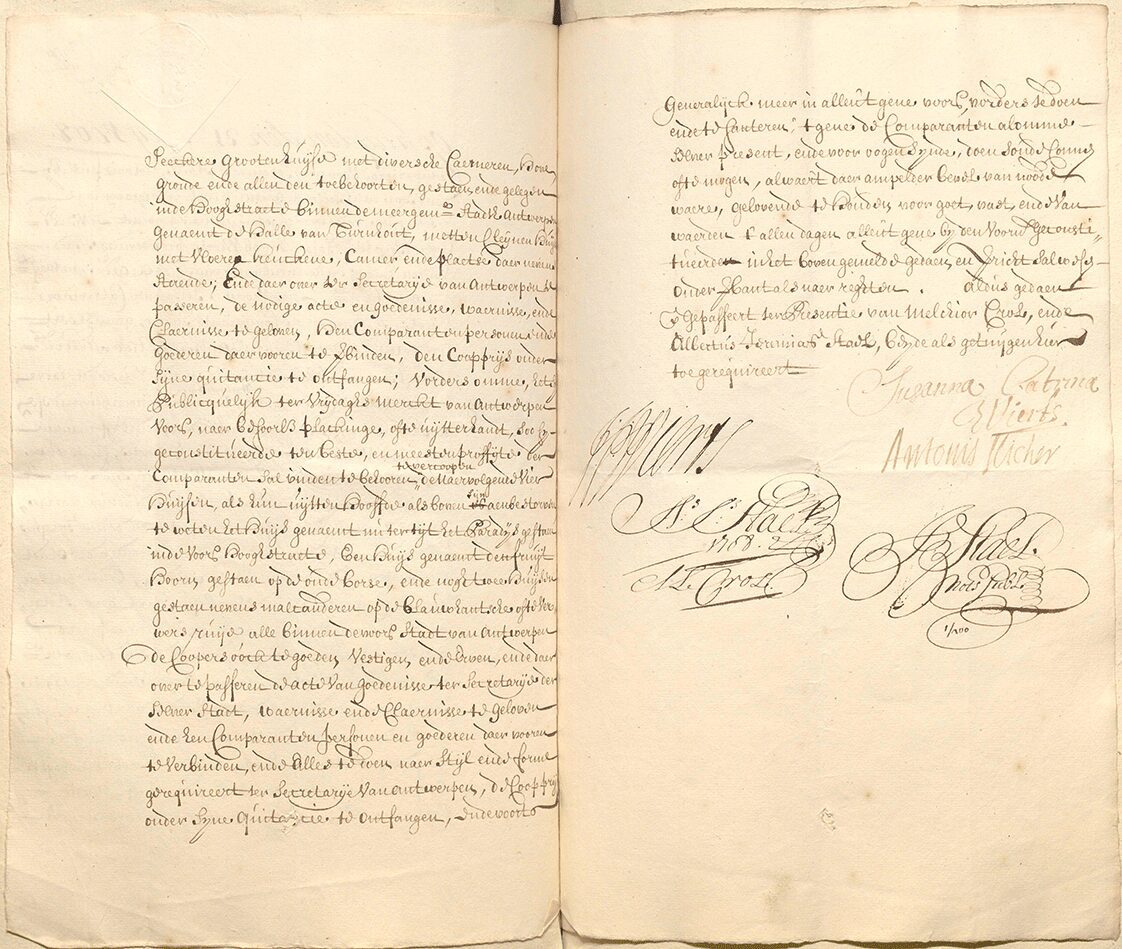
How to cite this item?
L. Kelchtermans, ‘New Archival Document about the Sale of Jacob Jordaens’ House in 1708’, Phoebus Findings, https://phoebusfoundation.org/phoebus_findings/1/, accessed on [dd.mm.yyyy].
All rights reserved. No part of this Phoebus Finding may be reproduced, stored in an information storage and retrieval system or transmitted in any form or by any means, whether electronic or mechanical, including copying, recording or otherwise, without prior permission in writing from The Phoebus Foundation. If you have comments or want to make use of our images, we’d like to hear from you. Contact us at: info@phoebusfoundation.org
Footnotes
- L. Kelchtermans, ‘Bij de schilder thuis: de pronkkamer’, Openbaar Kunstbezit Vlaanderen Thema: Thuis bij Jordaens (2021): 18-27.[↩]
- L. Kelchtermans & K. Van Cauteren, ‘Jacques Jordaens as Family Man: New Information about the Painter and His Family in The Hague’, Oud Holland, 134, 1 (2021): 25-48.[↩]
- R.J. Tijs, P.P. Rubens en J. Jordaens. Barok in eigen huis: Een architectuurhistorische studie over groei, verval en restauratie van twee 17de-eeuwse kunstenaarswoningen te Antwerpen, Antwerp, 1983: 298-302.[↩]
- ‘eenige naegelaetene kinderen ende Erffgenaemen [in margine: wonende alhier inden Hage; mij notaris bekent] van wijlen Vrouwe Anna Catharina Jordaens, huijsvrouwe van wijlen den Ed:[ele] Heer Johan Wierts, in syn leven
outPresident vanden raede van Brabant, ende eenige naergelaeten doghter ende Erffgenaem van wylen de heer Jacques Jordaens haere Vaeder, in sijn leven inwoonder der Stadt Antwerpen, aldaer ab Intestato overleden.’The Hague, Municipal Archives (Gemeentearchief, HGA), Notarial Archives, access no. 0372-01, Notary Jeremias Stael, inv. 1230, dated 21 May 1708.[↩] - This amount was specified in the Antwerp deed: 16,500 guilders. Tijs 1983: 298.[↩]
- ‘seeckere grooten huijse met diversche Caemeren, Hove, gronde ende allen den toebehoorten, gestaen ende gelegen inde Hooghstraete binnen de meergem[eld]e Stadth Antwerpen genaemt de Halle van Turnhout, metten Cleijnen Huijse met vloere, keuckene, Camer ende plaetse daer nevens staende.’ HGA, Notarial Archives, access no. 0372-01, Notary Jeremias Stael, inv. 1230, dated 21 May 1708.[↩]
- R.-A. d’Hulst & N. De Poorter, ‘Chronologie’, in: H. Devisscher & N. De Poorter (ed.), Jacob Jordaens (1593-1678): Schilderijen en wandtapijten, exh. cat., Antwerp, Royal Museum of Fine Arts, 1993: 8-9.[↩]
- P. Génard, ‘De nalatenschap van Adam van Noort. Brief aan den heer advocaat Th. Van Lerius’, De Vlaamsche School, 15 (1869): 50-53.[↩]
- ‘administratie [over te nemen] van de huijsen die sy comparanten in het gemeen nogh hebben staende binnen de Stadt van Antwerpen, de huijren vande selve huijsen te ontfangen, de reparatien die provisioneel nodigh sijn te besorgen, Ende oock de gem[eld]e huijsen te V[er]coopen tot soodaenigen prijse als gem[eld]e heer geconstitueerde door wisselingh van brieven met de Constituanten naeder sal concerteren.’ HGA, Notarial Archives, access no. 0372-01, Notary Jeremias Stael, inv. 1230, dated 27 March 1710.[↩]
- ‘Susanna Begoden, weduwe [van] Frans de Coninck.’ HGA, Notarial Archives, access no. 0372-01, Notary Jeremias Stael, inv. 1230, dated 21 March 1713.[↩]
- Kelchtermans-Van Cauteren 2021: 27, 37-39.[↩]
- HGA, Notarial Archives, access no. 0372-01, Notary Abraham Cortebrant, inv. 2436, No. 11, ‘Schilderijen van Historien als andere konstige stukken’; ‘Catalogus van schilderyen, Van Jacques Jordaans, verkogt den 22 Maart 1734 in ’s Hage’, in: G. Hoet, Catalogus of naamlyst van schilderyen met derzelver pryzen, 1, The Hague, 1752: 400-406.[↩]
- Tijs 1983: 350-351.[↩]